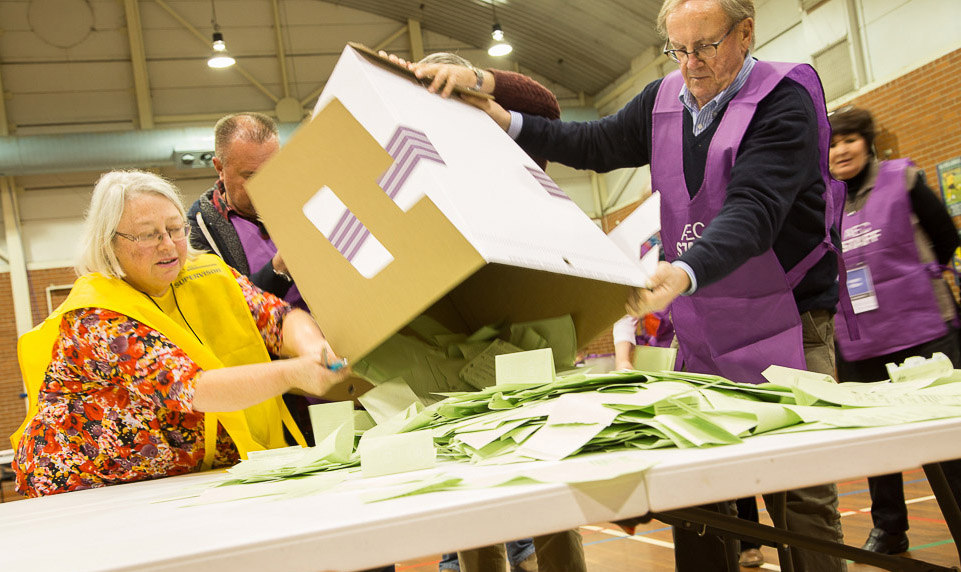Rosa O’Hara is a staff writer at Noema Magazine. She previously worked as a reporter in Indonesia.
Rosa O’Hara is the social editor at The WorldPost.
FREMANTLE, Australia — Earlier this year, Bruno Mars won album of the year at the Grammys, leaving the Internet baffled. Rap and hip-hop fans argued their votes had been split between three nominations: Jay-Z, Kendrick Lamar and Childish Gambino, paving the way for Mars’s supporters to out-vote them, even though the combined rap and hip-hop fan base was much bigger.
Sure, the Grammys result didn’t threaten democracy — the free world isn’t now ruled by a fedora-wearing tenor singer with a penchant for wearing sunglasses indoors — but what happened at the 2018 Grammys is indicative of a larger problem in the U.S.: the spoiler effect.
The spoiler effect occurs when political candidates capture a certain voting niche, siphoning off votes from another candidate. This paves the way for another candidate to win, even if the combined voting base of the other candidates is larger. Remember Ralph Nader and the 2000 U.S. election? The tens of thousands of votes cast in Florida for Nader, who didn’t even come close to winning, could’ve really helped Al Gore, the Democratic candidate, defeat George W. Bush, who won there by the skin of his teeth.
Australia — where I’m from — adapted pretty early to the problem of split votes when the government introduced compulsory preferential voting a century ago. Preferential voting is a system where voters rank their choices, and votes are then counted in rounds. In some places, it’s known as instant runoff voting or ranked-choice voting. The premise is simple. Voters’ first choices are counted, and if no candidate won more than 50 percent, the loser is knocked out. If you voted for the candidate who’s now out, your second choice is counted instead. And so on. It’s a process of elimination. The first candidate to reach more than half the vote wins. Basically, this system identifies whom people don’t want elected. It also means smaller parties can gain traction.
Only a small number of electorates around the world use a variant of this system. Ireland’s presidential election and some elections in Malta and India use adaptations, as do Scotland’s local elections.
The Australian political landscape is very different from the U.S.’s, in part due to this system. The major Australian parties have become “interest aggregators” in order to target the median voter — a strategy stemming from the idea that all voters can be located somewhere on a bell curve. In this system, there is also an intense period of bargaining for preferences just prior to elections, when parties make deals in order to be listed high on another’s preferences.
This means that the issues of smaller parties can be incorporated into the policy of the two main parties. For example, for the last few decades, the Australian Labor Party, one of the two main parties, and the Australian Greens, which is much smaller, have had what’s called a preference “flow” with each other in many electorates. This means the Labor Party tells its voters to list the Greens high on its preferences, and vice versa — but to do so, Labor had to weave environmental policy into its platform.
This voting system has proved to be powerful. The rate of lower house seats won by preference distribution in Australia has tripled over the past half-century, according to a forthcoming paper by Benjamin Reilly from Murdoch University in Perth. In 2016, 16 seats were won by candidates who were not ahead after the first votes were counted.
Preferential voting also appears to prevent extremist politics from gaining traction. The bigger parties don’t give preferences to Australia’s One Nation party, which disgorges Islamophobic rhetoric to the point that its leader once sat in parliament wearing a burqa in a bid to have them banned. One Nation had a huge voting swing in its favor in the 2016 state election in Queensland but was only able to gain one seat, thanks to the preference flow. Neither of the two main parties wanted to have anything to do with it.
Though it’s not used in the U.S. for presidential elections (yet), preferential voting was invented there. Political scientists credit William Robert Ware, a professor at the Massachusetts Institute of Technology, with coming up with the idea around 1870. And, more recently, the system has had bipartisan support: Senator John McCain has backed it, and Barack Obama introduced a bill for it in 2002 as an Illinois state senator.
There’s a particularly strong push for it in Maine, a state with an independent streak and a high rate of third-party candidates. City council elections in San Francisco and Oakland have adopted it, as have some of the country’s top universities for their student elections. Even the Academy Awards decided the first-past-the-post system was unfair for its best picture award.
Preferential voting has several advantages over other election systems. One key strength is that it encourages moderate politics — candidates benefit when they appeal to the broadest range of voters. During the Oakland mayoral election in 2010, candidate Jean Quan focused on convincing voters who had already decided on another candidate to choose her as their second or third preference. The frontrunner, Don Perata, was polarizing and was wiped out after Quan headed an unofficial coalition among other candidates and won based on second and third-preference votes.
Preferential voting also appears to drive voter turnout — people seem more empowered by the system because the result is in the control of the many, not the few. After St. Paul, Minnesota adopted a preferential voting system last year, it had a turnout of 33 percent, almost double the number in its 2013 mayoral elections and the highest turnout since 2005, according to city officials.
There are downsides, however. A voter’s second or third choice is given equal weight (though counted later) to that of a voter’s first choice, for example. And though the system is comparatively easy to implement in local elections, implementing it in statewide or nationwide elections requires an overhaul of multiple voting systems.
But for many political scientists and a growing number of politicians these days, the positives in preferential voting outweigh the negatives. In America’s first-past-the-post voting system, a centrifugal force pulls politics to each end of the spectrum, dividing voters. In Maine, Australia and other electorates with preferential voting, that force is centripetal: it’s in the interest of political parties and politicians to attempt to appeal to every voter.
Isn’t that what democracy is meant to do? Enacting the will of the majority while looking after the minority. Preferential voting is a system where not everyone gets exactly what they want, but at least most people get something.
This was produced by The WorldPost, a partnership of the Berggruen Institute and The Washington Post.





